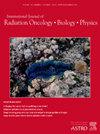质子束治疗口咽癌毒性降低III期试验的初步结果(鱼雷;CRUK/18/010)
IF 6.5
1区 医学
Q1 ONCOLOGY
International Journal of Radiation Oncology Biology Physics
Pub Date : 2025-10-14
DOI:10.1016/j.ijrobp.2025.08.026
引用次数: 0
摘要
目的:探讨调强质子治疗(IMPT)与调强放疗(IMRT)治疗局部晚期口咽鳞状细胞癌(OPSCC)的临床疗效差异。材料/方法在这个3期试验中,随机、对照、多中心的OPSCC患者需要明确的双侧放化疗,以2:1的比例分配到IMPT或IMRT (70 Gy (RBE),分33次,每天一次,持续6.5周),同时进行两个周期的顺铂化疗(每3周,100mg/m2)。放疗后12个月的共同主要终点是:(i)临床报告的胃造口依赖或CTCAE 3级体重减轻(比基线减少20%)和(ii)患者报告的华盛顿大学生活质量(UW-QOL)唾液、味觉、咀嚼、吞咽、言语和外观的物理综合评分;每个测试在2.5%显著性水平。分析考虑了肿瘤(T)和淋巴结(N)分期、吸烟状况、接受的化疗、基线体重指数和基线UW-QOL身体综合评分。次要终点包括MD安德森吞咽困难量表(MDADI)、无局部复发和总生存期。2020年3月至2023年6月,来自20个英国中心的205名局部晚期OPSCC患者(48%为T3/4, 21%为N2(c), 31%为≥10 pack year病史)被分配到IMPT (n=136)或IMRT (n=69)。IMPT和IMRT治疗的中位时间为44天(IQR: 44,44)。分别有5名(3.8%)和3名(4.5%)接受IMPT和IMRT的患者未给予第二周期化疗。178/205 (119 IMPT; 59 IMRT)的临床共同主要终点可评估,记录了胃造口依赖或体重减轻的数据。两组胃造口依赖率均较低:IMPT 2/119 (1.7%) vs IMRT 1/59(1.7%)。IMPT组3级体重减轻率更高:20/110(18.2%),而IMRT组3/53 (5.7%);综上所示,IMPT的优势比为2.8 (97.5% CI: 0.8, 10.4, p=0.080)。155/205名参与者(100名IMPT; 55名IMRT)可评估患者报告的共同主要终点。没有证据表明IMPT与IMRT的平均UW-QOL物理综合评分有差异(78.3 vs 77.1,差异=1.3(小数点后1位),97.5% CI: -3.7, 6.2, p=0.563)。IMPT和IMRT 12个月时的mddi平均综合评分分别为79.4和79.5。在27个月的中位随访中,IMPT和IMRT的2年局部区域无复发率分别为94.8% (99% CI: 85.8, 98.2)和96.8%(81.6,99.5),总生存率分别为94.4%(85.9,97.9)和94.9%(79.1,98.8)。结论对于局部晚期OPSCC,与IMRT相比,IMPT不能减少长期胃造口依赖或严重体重减轻,也不能改善患者报告的长期身体生活质量或吞咽功能。没有必要将IMPT作为高质量IMRT的替代方案。本文章由计算机程序翻译,如有差异,请以英文原文为准。
Primary results for the phase III trial of Toxicity Reduction using Proton Beam Therapy for Oropharyngeal Cancer (TORPEdO; CRUK/18/010)
Purpose/Objective(s)
To investigate differences in clinical outcomes between intensity-modulated proton therapy (IMPT) and intensity-modulated radiation therapy (IMRT) for patients with locally advanced oropharyngeal squamous cell carcinoma (OPSCC).
Materials/Methods
In this phase 3, randomised, controlled, multicentre trial participants with OPSCC requiring definitive bilateral chemoradiation were assigned in a 2:1 ratio to IMPT or IMRT (70 Gy (RBE) in 33 once daily fractions over 6.5 weeks), with two cycles of concurrent cisplatin chemotherapy (every 3 weeks, 100mg/m2). Co-primary endpoints at 12 months after radiation were: (i) clinician-reported gastrostomy dependence or CTCAE grade 3 weight loss (20% decrease from baseline) and (ii) patient-reported University of Washington quality of life (UW-QOL) physical composite score of saliva, taste, chewing, swallowing, speech and appearance; each tested at the 2.5% significance level. Analysis accounted for tumour (T) and nodal (N) stage, smoking status, chemotherapy received, baseline body mass index and baseline UW-QOL physical composite score. Secondary endpoints included MD Anderson Dysphagia Inventory (MDADI), freedom from loco-regional recurrence and overall survival.
Results
205 participants with locally advanced OPSCC (48% T3/4, 21% N2(c), 31% ≥10 pack year history) from 20 UK centres were allocated to IMPT (n=136) or IMRT (n=69) between March 2020 and June 2023. Treatment was delivered over a median of 44 days (IQR: 44, 44) for both IMPT and IMRT. A second cycle of chemotherapy was not given for 5 (3.8%) and 3 (4.5%) patients receiving IMPT and IMRT, respectively. 178/205 (119 IMPT; 59 IMRT) were evaluable for the clinical co-primary endpoint, with data recorded for gastrostomy dependence or weight loss. Both groups had low rates of gastrostomy dependence: IMPT 2/119 (1.7%) vs IMRT 1/59 (1.7%). A higher rate of grade 3 weight loss was seen for IMPT: 20/110 (18.2%) vs IMRT 3/53 (5.7%); taken together, the odds ratio for IMPT was 2.8 (97.5% CI: 0.8, 10.4, p=0.080). 155/205 participants (100 IMPT; 55 IMRT) were evaluable for the patient reported co-primary endpoint. There was no evidence of a difference in mean UW-QOL physical composite score for IMPT vs IMRT (78.3 vs 77.1, difference=1.3 (to 1 decimal place), 97.5% CI: -3.7, 6.2, p=0.563). MDADI mean composite scores at 12 months for IMPT vs IMRT were 79.4 vs 79.5. At a median follow-up of 27 months, 2-year freedom from loco-regional recurrence for IMPT and IMRT was 94.8% (99% CI: 85.8, 98.2) and 96.8% (81.6, 99.5) and for overall survival 94.4% (85.9, 97.9) and 94.9% (79.1, 98.8), respectively.
Conclusion
For locally advanced OPSCC, IMPT does not reduce long-term gastrostomy dependence or severe weight loss and does not improve long-term patient-reported physical quality of life or swallow function compared with IMRT. There is no requirement for IMPT as an alternative to high quality IMRT.
求助全文
通过发布文献求助,成功后即可免费获取论文全文。
去求助
来源期刊
CiteScore
11.00
自引率
7.10%
发文量
2538
审稿时长
6.6 weeks
期刊介绍:
International Journal of Radiation Oncology • Biology • Physics (IJROBP), known in the field as the Red Journal, publishes original laboratory and clinical investigations related to radiation oncology, radiation biology, medical physics, and both education and health policy as it relates to the field.
This journal has a particular interest in original contributions of the following types: prospective clinical trials, outcomes research, and large database interrogation. In addition, it seeks reports of high-impact innovations in single or combined modality treatment, tumor sensitization, normal tissue protection (including both precision avoidance and pharmacologic means), brachytherapy, particle irradiation, and cancer imaging. Technical advances related to dosimetry and conformal radiation treatment planning are of interest, as are basic science studies investigating tumor physiology and the molecular biology underlying cancer and normal tissue radiation response.

 求助内容:
求助内容: 应助结果提醒方式:
应助结果提醒方式:


